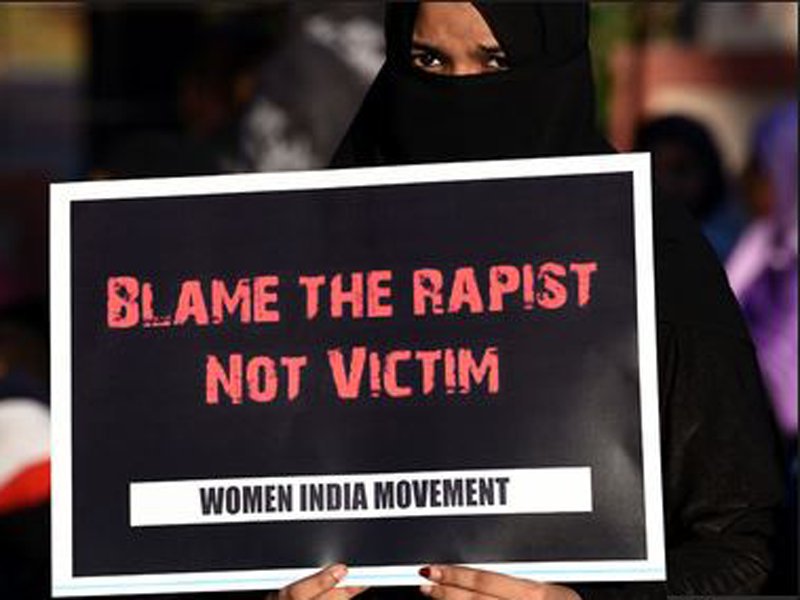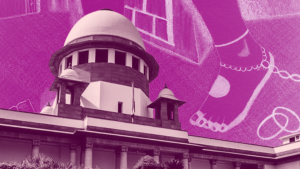Why Courts Must Stop Fixating On The ‘Modesty’ Of Survivors Of Sexual Violence

The use of the archaic idea of feminine “modesty” in the interpretation of the penal laws on sexual violence is regressive because it undermines the violation of the victim’s body, and is premised on the misplaced idea of an “ideal victim” and excludes many on the grounds of caste, class, sexual history, profession and gender identity, say legal scholars and gender activists.
Early last month, while hearing a case of sexual harassment, the judge in the Kozhikode Sessions Court, Kerala, while granting bail held that a prima facie case of sexual harassment will not stand against the accused as the offence cannot be said to be committed because the complainant was wearing “sexually provocative dresses”. In another case against the same accused, the same judge observed while granting anticipatory bail: “It is highly unbelievable that he will touch the body of the victim fully knowing that she is a member of a Scheduled Caste. The accused is a reformist and is engaged in social activities and he is against the caste system.”
There are several such instances where courts have cited subjective views on modesty, propriety and morality in their judgements and observations.
- The acquittal of journalist Tarun Tejpal in 2021 in a sexual assault case by a Goa sessions court was based on the observation that the complainant’s actions “did not demonstrate any kind of normative behavior that a victim of sexual assault might plausibly show”.
- In 2007, in the case of Ramkripal v State of Madhya Pradesh, the apex court observed that “the essence of a woman’s modesty is her sex”. While making this observation the court referred to an earlier judgement wherein it defined modesty as “womanly propriety of behaviour; scrupulous chastity of thought, speech and conduct”.
- In 2016, the Supreme Court acquitted those accused of raping a domestic worker in Bengaluru on the basis of the statements of medical experts that the complainant was “habituated to sexual intercourse”. This, the court held, made her testimony unreliable. A witness statement that the survivor did not seem distressed after the crime, and chose to stay late at night at the scene of the crime and inquire about the accused, was used by the court to conclude that she was an “immoral character”.
- In 2020, in a case where rape was alleged by a woman who was lured into sex on the promise of marriage, a Karnataka High Court judge observed that it is “unbecoming of an Indian woman” to have fallen asleep after the alleged crime. Even though the contentious phrase was later expunged, it remains an example of how courts work with the idea of a victim criteria.
What the law says
There are two sections of the Indian Penal Code (IPC) that refer to the idea of modesty in connection with sexual crimes: Sec. 354 provides for the offence of “assault or criminal force to woman with intent to outrage her modesty”. A sub-section, 354-A, deals with sexual harassment and the punishment for it. Under Sec. 509, the law provides for the offence of “word, gesture or act intended to insult the modesty of a woman”.
“The Indian Penal Code dates back to 1860 and was built on Victorian notions of society. The laws themselves are outdated and despite the several amendments to them which provide that the sexual history or character of the prosecutrix is irrelevant in determining consent, the notions of modesty continue to govern litigation in sexual violence cases, “ said Manjula Pradeep, a lawyer and human rights activist. An assault on bodily integrity cannot be scrutinised in terms of the victim’s modesty, she added.
The amendment to criminal law she is referring to is Sec. 53-A, added in 2013 to the Indian Evidence Act, 1872, which states that the victim’s character or previous sexual experience is irrelevant in a prosecution for an offence of sexual violence under the IPC and these have no links to the issue of consent.
Also, the apex court in a 2021 judgement held that “the following conduct, actions or situations are hereby deemed irrelevant — to say that the survivor had in the past consented to such or similar acts or that she behaved promiscuously, or by her acts or clothing, provoked the alleged action of the accused, that she behaved in a manner unbecoming of chaste or ‘Indian’ women, or that she had called upon the situation by her behaviour, etc”.
Despite these changes, courts continue to harp on the idea of modesty and an imaginary ideal victim, as we detail later.
An ‘ideal’ victim
The Kozhikode sessions court is not the first instance of a complainant’s conduct being used as a ground for bail or acquittal of the accused. In several cases the courts in India have made observations about how an “ideal” victim of sexual violence should behave during and after the crime. These notions are rooted in patriarchal beliefs and gender stereotypes, say experts.
In a 2005, in a case relating to the rape of 13 minor girls in an ashram by a godman, the apex court said that the crying of an inconsolable minor victim inspired the bench’s confidence in her testimony. In another case in 2007 wherein the accused had induced a 13-year-old girl into sexual intercourse on the promise of marriage – and a resulting pregnancy – the court observed that sexual violence robs the victim of her “most valued possession, her chastity or virginity”.
A similar observation was made in the Swami Chinmayanand @ Krishna Pal Singh v. State of Uttar Pradesh where the court said a delay in reporting cost a complainant her credibility because she should have sought immediate justice for the violation of her “most valuable possession”.
So who is an ideal victim of sexual violence, according to Indian courts? Here is a collection of such “norms” laid down by various courts: She is someone who protects her modesty and virginity at all costs, shows her express unwillingness and anguish at being violated, and resists the violence to the point of sustaining an injury. She also must not display “promiscuous attitudes” such as smoking or being sexually active.
In the laying down these standards for ideal victimhood, the courts in referring to “Indian values” borrow from Manu’s Brahminical law pertaining to ideal womanhood, thus putting the Bahujan woman outside the scope of the modern criminal justice system, wrote Disha Wadekar, a Delhi-based lawyer, in an essay in the Economic and Political Weekly.
“For Bahujan (caste oppressed) and trans women, relegated to the sphere of vulnerabilities, and often viewed as lacking virtue and ritual purity owing to their caste positionality, it is virtually impossible to fall within the ideal victim construct deemed credible by the courts.”
When modesty is a class/caste privilege
How India’s justice system deals with cases of sexual violence against women from marginalised communities reflects the Brahminical patriarchy inherent in it, said lawyer-activist Pradeep.
“In cases relating to Dalit, Adivasi and Bahujan women, they are labeled as impure and defiled, and the observations are made around controlling their sexuality. This clearly indicates that women from marginalised communities lie outside these notions of who is a modest woman. If a marginalised woman is sexually harassed, her caste becomes a determinative factor resulting in undermining of caste-based violence,” she said.
Wadekar pointed out two landmark cases to explain why the emphasis on modesty and ideal victimhood is problematic, especially when the survivor is from a marginal social group: the Mathura rape case (1972) and the Bhanwari Devi’s rape case (1993). In the first case, the sexual history of the victim and her being “habitual to sexual intercourse” were used as grounds for assuming her consent and acquitting the accused. In the Bhanwari Devi case, the trial judge observed that the caste hierarchy would not allow the alleged accused, “an upper caste man to defile himself by raping a woman from an inferior caste”.
Caste holds a dual disadvantage for victims of sexual violence, said independent researcher Vikramaditya Sahai, pointing to the Kozhikode case. “The accused man’s caste-progressive ideas and his age offer him a space where he is considered to have transcended his sexuality. Whereas, for the Dalit woman, her clothes and her character are used to hint at her sexuality which is seen coded in the caste economy,” they said.
Neglecting the social context of sexual crimes
The binary of modesty/immodesty is also rooted in the cliched links people make between sexuality and communities, said researcher Sahai. “There are persons whose sexuality is always deemed to be ‘excessive’ — women from Dalit, Adivasi or Bahujan communities, sex workers, persons from the Hijra and other communities. Due to their identity, their appropriateness is never considered sufficient enough to be protected from such violations,” they pointed out. Then there are groups that are believed to be sexually “lacking”, such as transgender men, disabled persons, or aged men, and because of this sexual crimes perpetrated on them go unrecognised, they added.
As we have reported, sexual violence is often used to reinforce caste hierarchies and the “honour” of women from marginal communities is violated to show them their “place”. There have been few convictions under the Scheduled Castes and the Scheduled Tribes (Prevention of Atrocities, POA) Act, 1989 in cases where the charge of sexual violence has been added under the IPC: the conviction rate in 2017-2019 in crimes under the PoA including rape and sexual harassment was about 27% and about 84% of cases were pending trial, as per the government’s 2021 report on Atrocities and Crimes Against Women and Children.
In the case of the rape of a Dalit minor girl, Ramdas & Ors. v State of Maharashtra, the apex court set aside the conviction under the Prevention of Atrocities Act stating that the mere fact of the victim’s caste does not attract conviction under the Act. In yet another case, Khuman Singh v State of Madhya Pradesh, the Supreme Court said there was not enough evidence to show that the offence was committed because the deceased victim belonged to a Scheduled Caste.
In a more recent observation, the apex court addressed the interplay between caste and gender of a victim of sexual violence, but the lack of evidence led to an acquittal. During the trial of the accused persons in the 2006 atrocities against Dalits in Khairlanji, Maharashtra, the court convicted them only for murder as no charge of rape was made due to the lack of evidence. It observed that the atrocities were rooted in revenge and not caste.
By placing an unrealistic expectation of burden of proof in cases such as this, the justice system neglects the socio-legal context in which the atrocities are perpetuated, say legal experts.
“The manner in which the legal system operates is not very different from the Manusmriti. Thus our laws and society consider those from marginalised communities as outliers. They are deemed to not inherit the same ‘modesty’, that is necessary for the “ideal victim” framework of the courts,” said Wadekar.
Even before the case reaches the court, there are multiple actors [who deal with it] such as the police authorities, the medical officers, the forensic officers, etc and even at these stages the scrutiny and investigation are not unbiased but a judgement is passed, she added.
From her experience in litigation, Wadekar points out that cases of sexual violence against Bahujan women are not even registered by the police. Instead, they are quick to file counter-cases brought by the alleged harasser. When the case reaches the courts, it appears from the police records that the accused person’s case was filed first and the victim’s filed in reaction to it.Police authorities often ask the victim to enter into a compromise with the alleged accused and settle it outside court, she added.
“A victim of sexual violence relies on the state for justice but the victim ends up being humiliated and re-victimised at the hands of the state authorities, due to her caste thus completely disregarding the violation of her bodily autonomy and the caste-based violence perpetuated against the victim,” Wadekar told us.
Sidelining transgender persons
This discriminatory outlook applies to the trans community as well. “If we look at the litigation surrounding Sec. 377, IPC, it has been a trend that only petitions of people belonging to upper classes are heard and their experiences are discussed,” said Rohin Bhatt, a lawyer and queer rights activist.
Till the Supreme Court judgement in National Legal Ser. Auth vs Union Of India & Ors (NALSA)in 2014 – the first time the court recognised non-binary gender identities and upheld the fundamental rights of transgender persons – the community’s freedoms were not protected by the law. Even the Transgender Persons (Protection of Rights) Act, 2019 invests them only with secondary citizenship, restricting their access to justice, said Sahai.
The Transgender Persons Act does provide for certain legal protections – against forced labour, discrimination in accessing public places, eviction, abuse for instance – but it requires the complainant to furnish an official identity card, pointed out Sahai. “To file a case under the Act, there must be a valid registration of the transgender person with the district magistrate. Thus to prove violence, they are first required to prove that they are a transgender person unlike a person from the gender binary,” they said.
Also, apart from the general offence of sexual abuse, which can be punished with a maximum imprisonment of two years, the Act does not cover other kinds of sexual violence against transgender persons. “The provision creates a vague category of sexual abuse without addressing a wide variety of sexual violences that are perpetuated against transgender persons. Most importantly, the issue of corrective rape is completely missing from the law. And the wide discrepancy in the penalties provided under the IPC and the Act further puts them at a disadvantage,” said Sahai.
It has been reported that police personnel often refuse to file complaints made by trans persons because they do not see them as victims of sexual violence. There are common sexual stereotypes attached to the trans community – for instance, that they are promiscuous or “asked for trouble” by soliciting strangers. This undermines the offence itself, pointed out Sahai.
Around 32% of transgender women in India have been forced into sex work, as per the last report of the National Integrated Biological and Behavioural Surveillance (IBBS) in 2014-15.
“The legal system fails to recognise the context and the power-play within which an offence of sexual violence takes place. It fails to acknowledge that something more than sexuality is violated and that atrocities based on caste, class, gender, profession, etc. are also present,” said Sahai.
We believe everyone deserves equal access to accurate news. Support from our readers enables us to keep our journalism open and free for everyone, all over the world.




